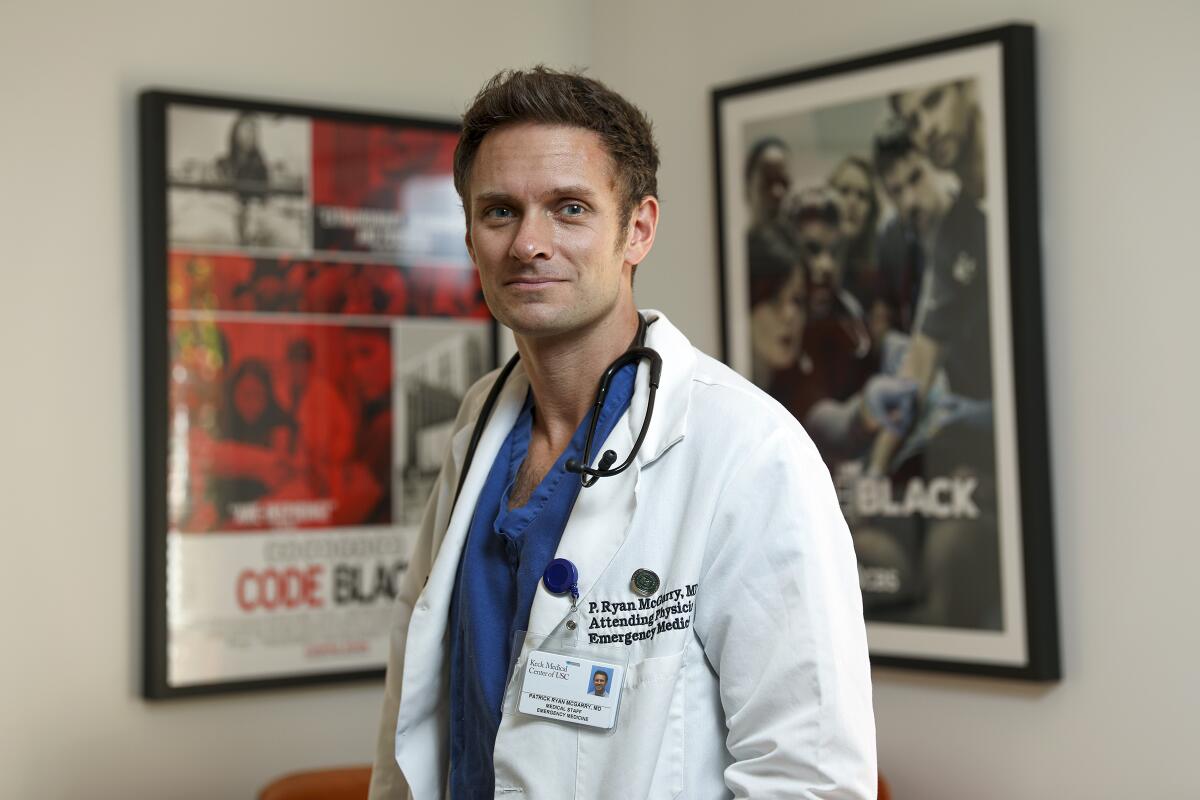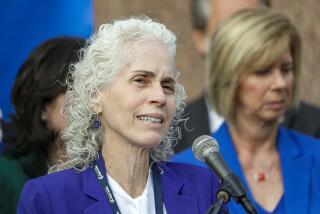This L.A. doctor’s film predicted a pandemic. Now the coronavirus consumes his life

- Share via
An obscure federal government bureaucrat stood in a field north of Pittsburgh last fall beside a mass grave. He looked soberly over the final resting place of dozens of victims of the great 1918 flu pandemic, which killed as many as 100 million people worldwide.
“This grave site is a reminder of the devastation a flu pandemic can wreak,” said Dennis Carroll, director of the Emerging Threats Unit of the U.S. Agency for International Development. “This kind of carnage is not relegated to history. When we talk about another flu pandemic happening, it’s not a matter of if, but when.”
That opening, of the six-part Netflix documentary “Pandemic: How to Prevent an Outbreak,” could not seem more pertinent, or ominous, today, as the world hunkers down in the face of a worldwide flu emergency.
Directing that scene in the Pennsylvania field was Ryan McGarry, a Los Angeles filmmaker and also a doctor, who now faces a potential flood of coronavirus patients to the emergency room where he works at Los Angeles County-USC Medical Center.
“I don’t really know how to feel right now,” McGarry, a doctor for Keck Medicine of USC, said in an interview. “I am glad that we were able to highlight the warnings of some very smart people. But as an artist and a physician, I can’t really begin to understand the level of suffering and ruin we may face. I mean, I think it’s going to change our lives forever.”
McGarry has been in high demand in recent days. “Pandemic” debuted in January, but recent events have pushed it into Netflix’s “Top 10 in the U.S. Today.”
The doctor-director-executive producer has appeared with Jake Tapper on CNN. He fields a slew of media calls. And he’s holding down two or three sessions a week at the Boyle Heights emergency room, where the first cases of the deadly virus have begun to appear.
He said he wants the public to recognize how not just doctors, but nurses, aides and support staff at hospitals will be working in a time of heightened risk.
“Imagine, you are the custodial staff. Before you were cleaning up messes. And now you are putting your life on the line,” McGarry said. “You are asking a lot of people to be very courageous right now. It’s incredible what ER workers are doing. And I think we all have a lot of respect for that.”
McGarry, 38, had always dreamed of a career as a storyteller. But a youthful brush with mortality helped also put the Southern California native on a path toward medicine, too.
He grew up in Orange County and became a top distance runner at Mater Dei High School in Santa Ana. As a freshman at Southern Methodist University, he got off to a winning start, but then saw his performance on the track drop off inexplicably.
His coaches suspected that he had been overtraining and cut his workouts. It took months before doctors diagnosed he had non-Hodgkin’s lymphoma. Stage 4. Two years of chemotherapy and other treatments followed before he was cancer-free.
“I’ll never forget what physicians did for me when I was sick,” McGarry said, “so I became dedicated to medicine, as well as to filmmaking.”
He went to medical school at the University of Pittsburgh and did his residency in emergency medicine at County-USC.
During that time, the hospital granted him permission to film life inside. The footage became the basis for “Code Black,” a 2013 documentary depicting the struggles of providing quality care in a habitually overcrowded hospital. The film won several awards.
“Pandemic” grew out of McGarry‘s conversations with others about the centenary of the so-called Spanish flu of 1918.
“We started looking into the people around the world and in the United States, whose entire careers were based on trying to make sure that 1918 never happened again,” McGarry said. “Yet most of these people, they were having their budgets slashed or they were not being taken seriously. And, well, here we are.”
The cast of “Pandemic” ranges from government officials such as Dr. Carroll to physicians in locales as far-flung as Oklahoma and India. It features Vietnamese chicken farmers trying to stave off avian flu, San Francisco researchers looking for a universal flu vaccine and the doctor charged with preparing New York City hospitals for a pandemic.
The latest maps and charts on the spread of COVID-19 in California.
Dr. Syra Madad, the senior director of New York City’s Health and Hospitals System-wide Special Pathogens Program, tells the filmmakers: “These threats are never going to stop and we need to do something about it. And that something is now.”
McGarry said he was fascinated by doctors and public health experts who have remained laser-focused on the pandemic threat, as the public’s mind strayed to a thousand other places.
“These people do not have the forgetfulness that most of us do,” he said. “They are hard-wired to be always on it. And thank goodness. Without people like this, we would be really screwed.”
McGarry runs a little still, to stay fit. Despite his telegenic appearance, he said he prefers to stay behind the camera and focus on others. He said doctors and other healthcare workers are not sanguine about the coming storm.
“I’m like any human being; I’m scared,” he said. “And we’re seeing that this virus seems to be less discriminatory in age than we had thought. You see that some young people and some young healthcare workers are going down with the virus, and that’s scary.”
“There is anxiety, but also resiliency,” he continued. “At our staff meetings, people have been asking questions like, ‘How can I get to the patients faster? What can I do to get involved?’ That’s pretty awesome, right?”
At a time of such stress, it’s hard to find silver linings, but McGarry thinks there could be one.
“Maybe we now come out of this unified and prioritize public health and the healthcare system in the way that we should. I sure hope so.”
More to Read
Sign up for Essential California
The most important California stories and recommendations in your inbox every morning.
You may occasionally receive promotional content from the Los Angeles Times.












